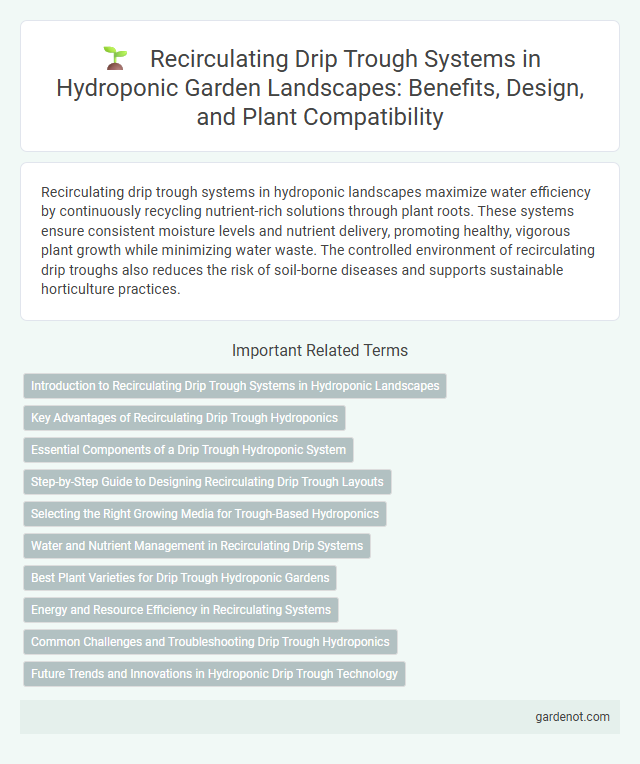Recirculating drip trough systems in hydroponic landscapes maximize water efficiency by continuously recycling nutrient-rich solutions through plant roots. These systems ensure consistent moisture levels and nutrient delivery, promoting healthy, vigorous plant growth while minimizing water waste. The controlled environment of recirculating drip troughs also reduces the risk of soil-borne diseases and supports sustainable horticulture practices.
Introduction to Recirculating Drip Trough Systems in Hydroponic Landscapes
Recirculating drip trough systems in hydroponic landscapes provide efficient water and nutrient delivery by continuously circulating solution through a network of troughs. These systems maximize resource use, reduce water waste, and ensure consistent nutrient availability for optimal plant growth. The design typically features a pump, reservoir, drip emitters, and return channels to facilitate closed-loop nutrient flow.
Key Advantages of Recirculating Drip Trough Hydroponics
Recirculating drip trough hydroponics maximizes water and nutrient efficiency by continuously recycling solutions, significantly reducing waste and operational costs. This system enhances root oxygenation and nutrient uptake through precise drip irrigation, promoting faster plant growth and higher yields. Automated recirculation also minimizes labor requirements and maintains consistent growing conditions, making it ideal for sustainable, large-scale hydroponic landscapes.
Essential Components of a Drip Trough Hydroponic System
A recirculating drip trough hydroponic system relies on essential components such as nutrient reservoirs, drip emitters, and trough channels designed to support plant roots while delivering a steady flow of nutrient-rich water. The system also includes a pump for continuous circulation, filtration units to prevent clogging, and timers for precise irrigation scheduling. Proper integration of these components ensures optimal nutrient absorption, water conservation, and enhanced plant growth in hydroponic landscapes.
Step-by-Step Guide to Designing Recirculating Drip Trough Layouts
Designing recirculating drip trough layouts involves first selecting appropriate trough dimensions to ensure optimal water flow and root space for hydroponic plants. Next, strategically position drip emitters along the trough to provide uniform nutrient distribution, preventing dry spots and promoting consistent growth. Finally, integrate a recirculation pump and reservoir system to maintain a steady nutrient solution cycle, enhancing efficiency and reducing water waste in the hydroponic landscape.
Selecting the Right Growing Media for Trough-Based Hydroponics
Selecting the right growing media for recirculating drip trough hydroponics is crucial for ensuring optimal water retention, aeration, and nutrient delivery to plant roots. Media such as expanded clay pellets, coconut coir, and perlite offer excellent drainage and support while facilitating efficient recirculation of nutrient solutions. Proper media choice enhances root health, minimizes disease risk, and promotes steady plant growth in trough-based hydroponic systems.
Water and Nutrient Management in Recirculating Drip Systems
Recirculating drip trough systems optimize water and nutrient management by continuously cycling nutrient-rich water through plant roots, minimizing waste and ensuring consistent delivery of essential minerals. These systems maintain precise nutrient concentrations, reducing leaching and promoting efficient absorption, which supports healthy plant growth and resource conservation. Advanced sensors monitor water quality and nutrient levels in real-time, enabling precise adjustments that enhance system sustainability and crop yield.
Best Plant Varieties for Drip Trough Hydroponic Gardens
Lettuce, spinach, and herbs such as basil and mint thrive in recirculating drip trough hydroponic systems due to their shallow root structure and fast growth rates. Tomatoes and strawberries also perform well, benefiting from consistent moisture levels and nutrient delivery. Choosing crops with compact root systems enhances nutrient efficiency and maximizes yield in drip trough hydroponic gardens.
Energy and Resource Efficiency in Recirculating Systems
Recirculating drip trough systems in hydroponic landscapes maximize energy efficiency by reducing water and nutrient consumption through precise delivery and reuse. These systems minimize waste by continuously cycling nutrient-rich solutions, lowering both water usage by up to 90% compared to traditional methods and energy costs tied to water pumping. Optimizing flow rates and pump operation further enhances resource savings, making recirculating drip troughs a sustainable choice for eco-friendly hydroponic cultivation.
Common Challenges and Troubleshooting Drip Trough Hydroponics
Recirculating drip trough systems in hydroponic landscapes commonly face challenges such as clogging of emitters due to nutrient buildup or algae growth, inconsistent water flow rates, and root zone oxygenation issues. Troubleshooting involves regularly flushing the system, using filtered water, adjusting emitter spacing, and monitoring nutrient concentrations to prevent blockages and ensure uniform plant hydration. Maintaining proper reservoir oxygen levels and routinely inspecting drip lines helps mitigate root diseases and promotes optimal plant growth in these hydroponic setups.
Future Trends and Innovations in Hydroponic Drip Trough Technology
Future trends in hydroponic recirculating drip trough systems emphasize integration with IoT sensors and AI-driven nutrient management to optimize water and nutrient delivery. Innovations include automated pH and EC adjustments, energy-efficient pumps, and modular designs that enhance scalability for urban farming. Advanced materials with antimicrobial properties are being developed to reduce biofilm formation and improve crop yield consistency.
Recirculating drip trough Infographic

 gardenot.com
gardenot.com